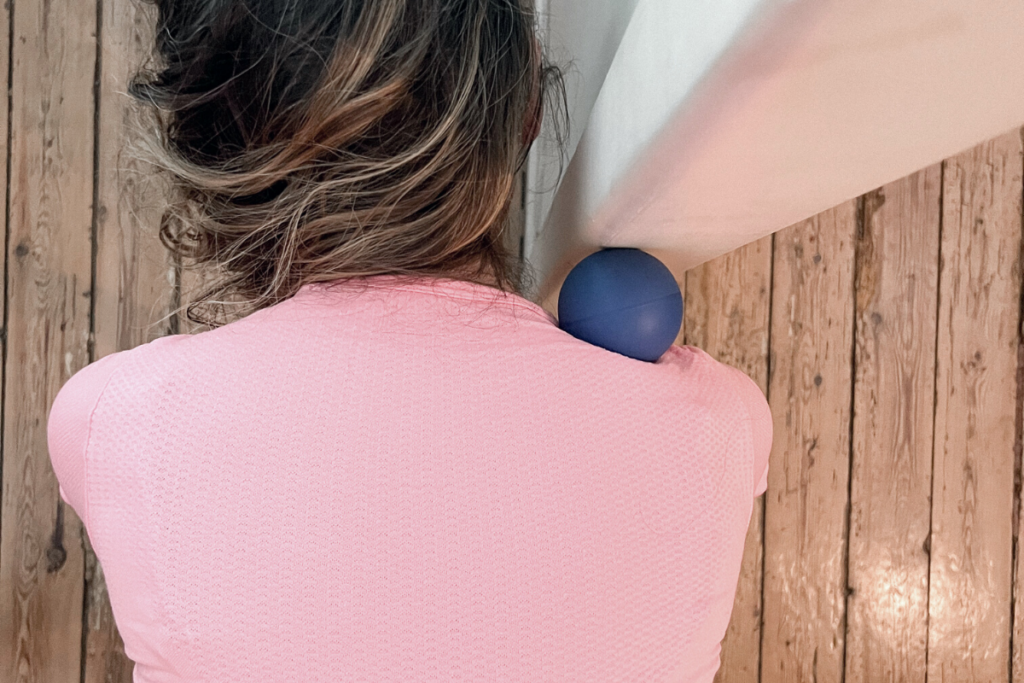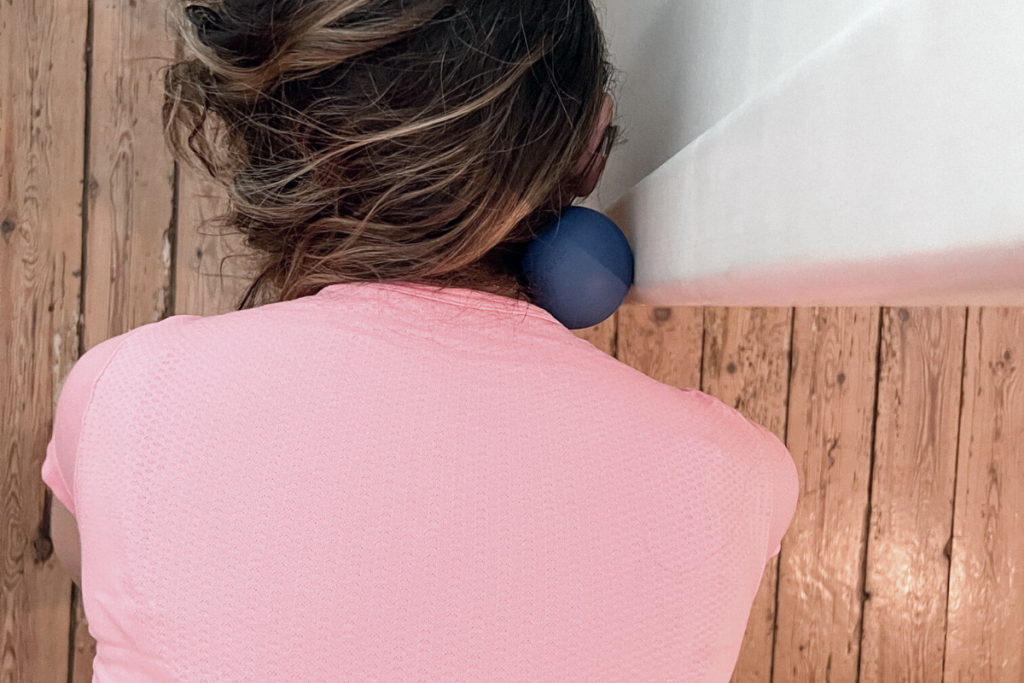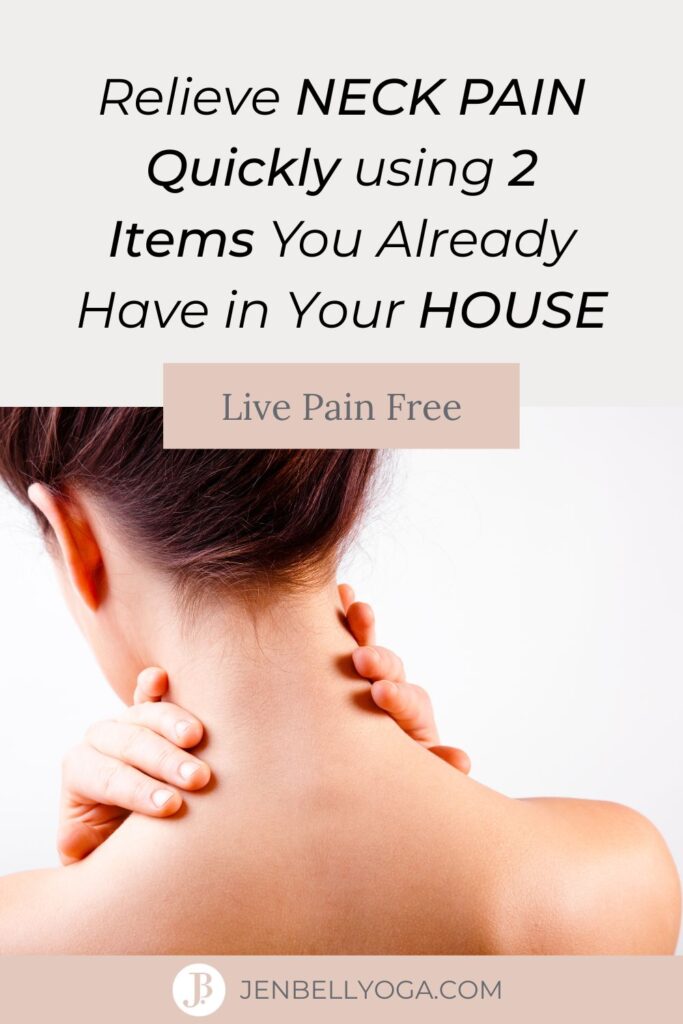
I’m sitting at my keyboard, shoulders sore from being lifted for so long. With my left hand, I squeeze and massage my right shoulder, which slowly softens away from my ear.
As I release my hands down to my keyboard, I realize NOW, my LEFT shoulder is sore from all the squeezing. 🙄
Do I repeat? Will I get stuck in a cycle? Or do I ask the hubs to do a little “trapezius squeezeius” for me?
Typically I ask the hubs for help, but I learned a super cool technique from the book The Role Model. It’s hundreds of pages of different ways to use massage balls to relax your ENTIRE BODY. But you don’t have time to roll out your WHOLE body, so this post and video are about how to release that literal pain in the neck.
This video shows how to release the muscles in your neck (and your upper traps) so you can find quick and effective relief. For this technique, read the post AND watch the video. This video was a challenge to shoot with my little tripod, so no matter your learning style it’ll be helpful to read AND watch.
** Reading Break ** This blog post DOES contain affiliate links of related products I love and they might even be pictured. If you click on a link and purchase a product (or service) it costs you nothing, you MIGHT even get a discount, and I MAY even receive a SMALL commission. This helps me to buy and drink coffee ☕️ in order to keep me awake and provide you with amazing free content 💗 Thank You for supporting my content 💋
I’m a mom of twin boys. My hands are full of children arms, half-eaten strawberry ice cream, and the car 🚘 my offspring NEEDED to take to dinner 🙄
I don’t have extra hands to carry special yoga equipment, but for these myofascial neck releases, I’ll drop that half-eaten ice cream and grab my tennis ball.
These techniques are now in my repertoire of go-to drills, cause at the end of my day, my neck is stiff and I long for some sweet release.
Thanks to this (and a few other techniques), I now keep a ball on every floor of my house, in my car, and even in my carry-on bag.
The 2 things you need:
This one is pretty self-explanatory, but what do you need to look for in a good wall?
They come in all shapes, sizes, textures, and densities; you may be overwhelmed with the choices, but for this technique, the most important quality is:
The ball needs to be small enough to comfortably fit between your neck and your shoulder
But if you already have a ball you think will work, grab it, and let’s get started. There’s no need to buy something special for this, but if you’re looking for one, or want to add to your collection, here are some of my favorites:
Tennis balls – New or old these are always a great choice! (Ok, maybe not the one your dog has been slobbering over for the past hour.) They’re inexpensive, you might even have some (slobber-free ones) lying around your house, and they have enough give to provide a great massage.
Lacrosse ball – With little give, lacrosse balls can help you achieve the most pressure, but more pressure doesn’t equal more relaxation. The reason why you see so many balls sold as “lacrosse myofascial release balls,” is because lacrosse balls (along with tennis balls) are the perfect size for most needs. Actual lacrosse balls are a more economical option, they’re cheaper than balls marketed for myofascial release.
Tune Up Fitness Therapy Plus Balls – These are my favorite! I have a whole kit of products from Tune Up Fitness, and these are the balls I use the most. They’re like the goldilocks for myofascial release balls: not too big, not too small, not too firm, and not too soft. They’re just right. Best of all, it’s a 2-pack! And the mesh sleeve it comes in can be handy for rolling out the spine and muscles around long bones.
Tune Up Fitness Alpha Ball – My second favorite ball in the kit. This ball is a bit larger and provides a more diffused pressure, it feels more soothing and less pointed. If you have any type of autoimmune disease (like fibromyalgia) or are physically more sensitive to sensations, I would splurge on this ball.
Let’s check. Are we on the same page? The spaces we’re massaging here are your: Upper Trapezius and various muscles in your Neck. Colloquially we refer to the upper traps as our “shoulders.” Technically the traps are not actually part of your shoulder, but they move the shoulders in a lot of directions. But you already knew that 🙌


Between the video, description, and photos I know you’ll find success. Did you watch the video? How did it go?
This technique is a myofascial release technique. Simply put, it means you’re “releasing” the fascia of the muscles.
Oh, what’s fascia? Technically, a layer of connective tissue surrounding every muscle, blood vessel, organ, nerve, and bone to keep them in place. For the purpose of this exercise, I’m only referring to your muscle fascia. Think of it as that outer white plastic of your cell phone charging cable. If you break the cable open you would find all those tiny colorful wires inside (your body’s equivalent of muscle fibers – yes they’re cased too).
Do you have that visualization?
So everything is held in place by fascia.
You might be wondering:
If it’s meant to hold everything in place then why would I want to release it? Wouldn’t I be a blob of jello?
Or
Lightbulb 💡
That explains why I feel so stiff!
(which one are you?)
We need to move so our fascia needs to move with us. The point of these myofascial release techniques is to soften the fascia so we can move freely, and that’s why they should be an integral part of your daily movement routine like the one below.
As we put pressure onto these spots we warm up that connective tissue making it a little more supple.
For our shoulders and necks, we lift those shoulders towards our ears a lot.
It’s ok! It’s a primitive protective mechanism designed to keep our body and our brain together. But with that, those muscles get a lot of extra work, stiffening our fascia into that raised shoulder, tense neck shape.
Now you have this technique, you can apply pressure to the fascia around your shoulders and neck, WITHOUT stiffening the fascia on the opposite side.
Voila!
Find out what’s going on… You know you want to… Privacy is important, I won’t sell your info, I promise.
If you read the last section I eluded to how this can be helpful in daily movement. Myofascial release (or massage) produces warmth that warms up the connective tissues (and muscles) so you can move and stretch with ease.
In my Yoga Therapy Thursdays (#YogaTherapyThursdays) series on Instagram and YouTube I reiterate over-and-over this order of movement:
Any myofascial technique can be inserted anywhere into this list, but to maximize your benefit think about your intention for your practice that day.
As a yoga therapist, I specialize in using yoga therapy techniques to help people with chronic headaches and migraines. I firmly believe any mindfulness practice (including mindful movement) is better than none, so doing this technique mindfully on its own is better than nothing. Check out this post where I lay out (in more detail) a couple of daily routines. But while you’re here, if you want to reduce chronic neck pain, headaches, or migraines I would do the following:
Nope. Not a typo.
I would book-end the stress reduction for any chronic condition.
This technique is perfect to release the muscles of the neck and shoulders, BUT, you CAN overdo it. In this blog post I talk about over-sensitization, what it is, and a few tricks to avoid it.
Now, if you’re thinking “I don’t have any chronic conditions, how often should I do this and when?” Well, you can do it anytime. Do this mid-day. It’s a great way to break up a long glassy-eyed, hunched over your desk, movement deprived day.
If you want to integrate myofascial techniques to increase your flexibility (we’re not talking about our necks here, just general flexibility), “rolling-out” right before you stretch can help you see the biggest benefit.
The ideal for your neck? Once or twice per day.
Pretty cool, right? If you found this useful hit that SUBSCRIBE button over on my YouTube channel, and sign up for my newsletter below for more practical tips and tricks.
Find out what’s going on… You know you want to… Privacy is important, I won’t sell your info, I promise.
